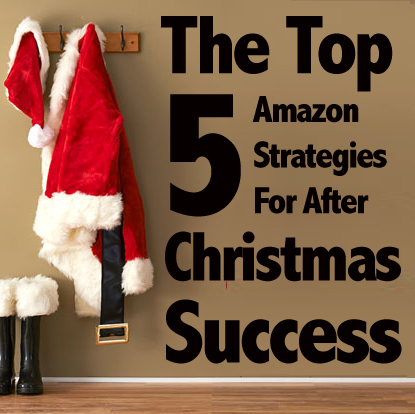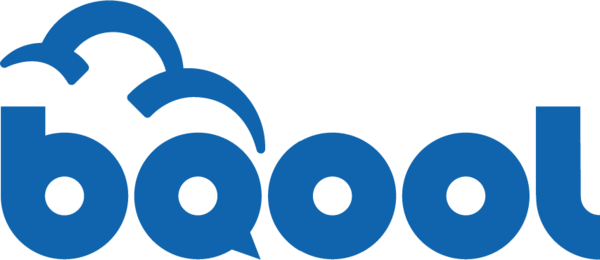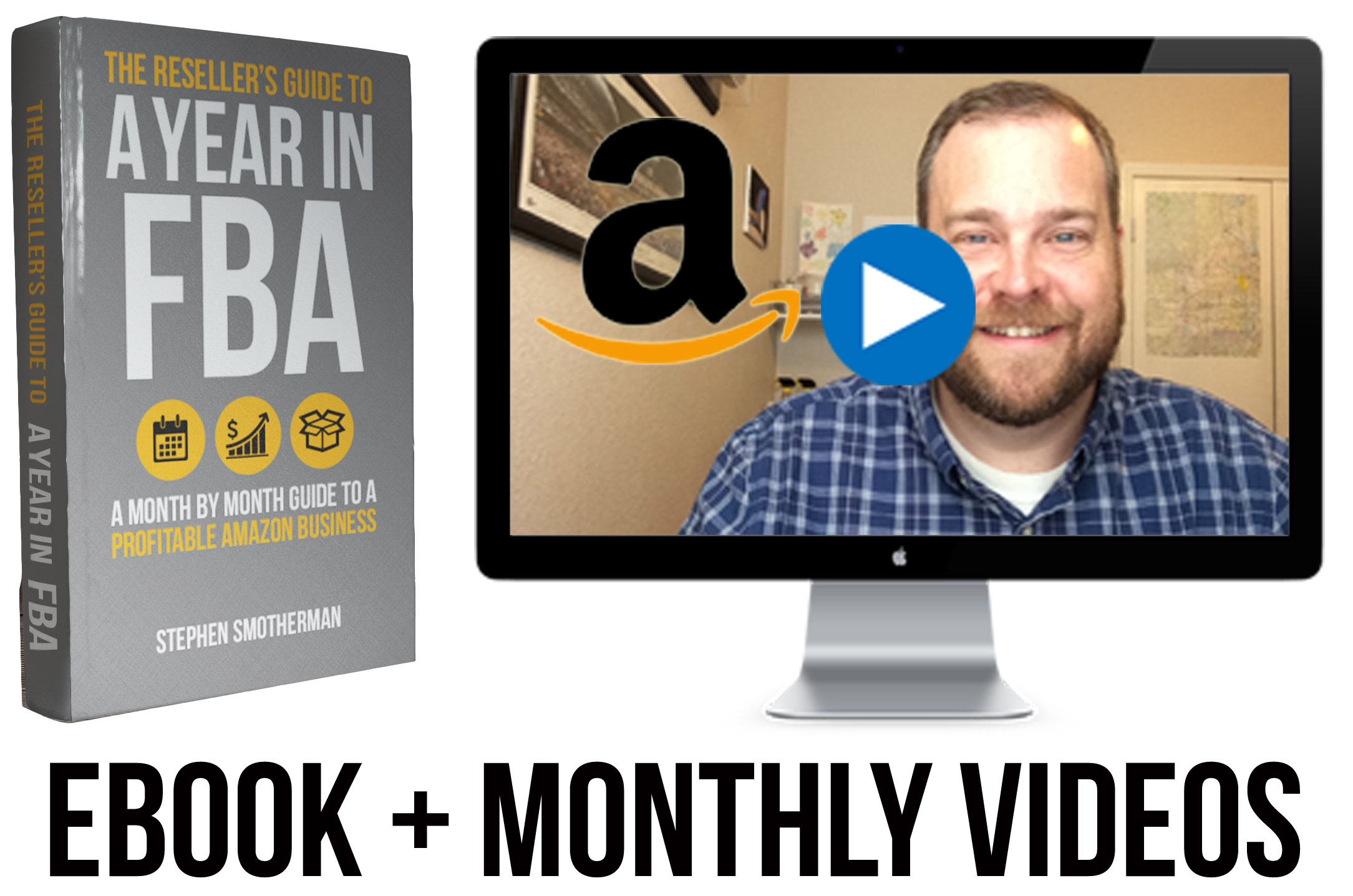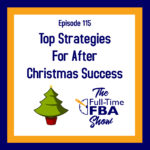Having a wise post-Christmas strategy is a great way to start the new year right! In today’s episode, Stephen and Rebecca share five ways to grow your Amazon FBA business after the Christmas rush, that you can start thinking about now. From not automatically lowering your prices and rather looking at the pricing trends first, to what to do if you’re low on sourcing funds, and how to work these strategies into your business model, we cover all the scenarios for this time of year.
Hear the Smothermans’ own personal and business goal-setting ritual, how to take proper advantage of clearance sales, and even specifics such as what to do if Amazon asks for a receipt or proof of authenticity and you don’t have one. There are tons of ways that you can set yourself up for success — and while you are ultimately the person who knows what will work for your business, this episode has tons of top tips and hacks to get you started! So if you need some inspiration for how to transition into the new year with a growth and success mindset, then be sure to listen today!
Listen on the podcast player below.
Like what you hear? Tell a friend… and be sure to leave us a rating and a review. Here’s how.
Key points from Episode 115:
 Why you shouldn’t automatically lower your prices just because Christmas and the holiday selling season is over.
Why you shouldn’t automatically lower your prices just because Christmas and the holiday selling season is over.- A hack for January if you’re low on sourcing funds and some guidelines on how to do it well.
- Some advice for dealing with inauthenticity claims and other times when Amazon requests a receipt.
- Checking out post-Christmas clearance sales; keeping other red-themed holidays in mind.
- Toys, gift-type items, and Rebecca’s favorite and most profitable tip!
- Hear the Smothermans’ personal and business goal-setting ritual and discover some resources to make your own.
- The final strategy: we recommend the best ways to put money back into your business.
- Using your own discretion in choosing what works for your individual business.
- A sneak peek into next week’s show, which promises to be light, entertaining, and very funny.
- And more!
Links and resources mentioned in this episode:
 Keepa – Amazon pricing and sales rank history
Keepa – Amazon pricing and sales rank history- Keepa 101 training video
- The Reseller’s Guide to Keepa
- BQool – Automatic Repricer
- How to Wisely Use Your Q4 Profits
- Full-Time FBA Facebook Group
- Join the Full-Time FBA newsletter
Right-click here and save as to download this episode to your computer.
 More Episodes from the Full-Time FBA Show podcast:
More Episodes from the Full-Time FBA Show podcast:
Don’t miss an upcoming episode! Subscribe, download episodes, and review the Full-Time FBA Show:
-
-
- Subscribe on iTunes
- Follow on Spotify
- Follow on Amazon Music (or just ask Alexa to “play The Full-Time FBA Show podcast”)
- Follow on iHeartRadio
- Subscribe on Podbean
- Subscribe on Podbay
- Subscribe on Podchaser
-
![]()
 The Reseller’s Guide to a Year in FBA
The Reseller’s Guide to a Year in FBA
A Month by Month Guide to a Profitable Amazon Business
One of the ways you can make selling on Amazon FBA easier is to know ahead of time exactly what to expect each and every month of the year.
Imagine what it would feel like knowing you were not missing out on any of the opportunities that will come your way this year. Imagine working on your Amazon business knowing exactly what your priorities are, what you need to avoid, and what you need to accomplish during each month to make progress toward making this year your best sales year ever.
Now you can with the course The Reseller’s Guide to a Year in FBA: A Month by Month Guide to a Profitable Amazon Business. The package includes a 275+ page ebook, monthly training videos, a private Facebook group, and more!
![]()
Back to the main page for The Full-Time FBA Show
![]()
Episode 115 Transcript:

[INTRODUCTION]
[0:00:01.8] ANNOUNCER: Welcome to The Full-Time FBA Show. In each episode, it’s our goal to help you turn part-time hours into a full-time income, selling almost anything on Amazon. Now, your hosts of the show, Stephen and Rebecca Smotherman.
[WELCOME]
[0:00:20.7] STEPHEN: Welcome to episode number 115 of The Full-Time FBA show. Today, we’ll be talking about five Amazon FBA strategies for after-Christmas success, because this episode is dropping the Monday before Christmas. So Rebecca and I want to wish you all a happy holidays, a Merry Christmas. In fact, Rebecca, you can say it yourself too if you want to.
[0:00:41.7] REBECCA: Sure, Merry Christmas everyone! I hope you are ready for this week that we’ve got ahead of us. I know I’ve still got a lot to get done, we’ve got family to see, it’s exciting, the kids are out of school, all the things. But we’re excited to be here with you today for this episode of The Full-Time FBA Show.
[0:00:56.6] STEPHEN: Absolutely and we’ll discuss the after-Christmas success strategies on today’s episode.
[DISCUSSION]
[0:01:07.0] REBECCA: We wanted to have this conversation today because a lot of sellers just kind of coast into January. They enjoy Q4, they especially enjoy late November, early December. Lots of sales, you’ve been working really hard, sending in lots of inventory. If you do merchant fulfilled, you’ve been shipping out lots of sales too, but then, we kind of just forget about January sometimes and we end up making some mistakes that cost hundreds, if not thousands of dollars in lost profits.
Having a wise post-Christmas strategy is really a great way to start off the new year. It’s actually the best way to start the new year off right, making sure that you are not just ending the year at Christmas and then kind of coasting into the New Year, and waiting until the middle of January to start having a new strategy that you put into place. Let’s talk today about some FBA strategies for after Christmas success that you can start thinking about now and put into place once the holiday’s over.
[0:02:01.2] STEPHEN: The first one we want to discuss today is not to automatically lower all your prices. Now, that might be something your competition is doing and you kind of want to make the right choice for your own inventory.
You want to look at Keepa graphs to see what pricing trends look like. Maybe, if it’s over 365 days’ worth of pricing trends, you can see what the price reacted last year at this time. Because a lot of times, there are competitors that will sell out of their inventory at lower prices but then after they sell out, the price recovers and you can still get higher prices.
Don’t automatically lower your prices, you can still sell some of those items to customers. Now, if you look at a Keepa graph and you look at the competition levels and it’s like, “Oh my gosh, there’s hundreds of sellers trying to sell it, they have so many in stock. I don’t think that the sales rank is going to really do well. I don’t think that the sales will last, it’s going to keep up with the number of competitors.” Then you know, yeah, lower your prices but don’t just automatically lower your prices on all your inventory just because it’s after Christmas.
[0:03:03.0] REBECCA: Okay, the second piece of advice that we have for you today is, for those of you who might be low on sourcing funds. Now, some of you, for various reasons might be kind of going into the new year not having just a ton of sourcing capital, and if this applies to you, we suggest that you look into thrifting in January.
Now, this isn’t going to be for everybody but for some of you, this might be a great way to find some low-cost inventory to send into the FBA warehouses. There’s going to be a lot of donations coming into thrift stores after Christmas and into the New Year because it’s just the time of year when people are cleaning out. They’re getting into their New Year’s resolution of decluttering their house or they are trying to find places for the new stuff that they got through the holidays and they’re having to clean up their house.
There’s going to be a lot of donations at these thrift stores and so you’re going to be able to go in and find profitable items. They’re in still-new condition, they’re shrink wrapped, they’ve never been opened, they might even still have tags on them and you can send that in to FBA and you might also find a lot of used or collectible items as well, so don’t forget to look for things in different conditions.
Be sure to make sure you grade things appropriately and put things in the right condition when you list it on Amazon. But this is a great place to go look. At this time of year, it’s a really great time to source at thrift stores.
[0:04:19.7] STEPHEN: Yeah, in my experience in the past, you can even potentially find so many items at thrift stores, there’s thrift stores that are overrun because there’s so many people donating to them. Some of them just even sell out big – lots of stuff that’s not even looked through or anything.
A lot of opportunities for you. We love selling used books, buying used books at thrift stores to sell on Amazon. Finding collectible boardgames that are complete to buy and sell on Amazon but I can already hear some of you trying to interrupt me, saying, “Stephen, what about the whole receipt issue?”
Yes, there is that issue when it comes to thrifting that you don’t get a receipt that matches the UPC of that particular item and so if Amazon asked you for proof of authenticity trying to prove that it’s a genuine article, you are not going to be able to have a receipt with the UPC connected to the store that you’re purchasing in from. And so when it comes to that, here are my thoughts.
First off, if you’re at a thrift store, don’t be buying things that people counterfeit. If you find a really nice purse or a nice pair of Air Jordan shoes, or something that other people might take the time to counterfeit, don’t go through the process of buying that to sell it. That’s not going to be a place to sell on Amazon.
Also, when you’re buying something at a thrift store, usually, it’s a one-off item, which means, you’re not going to go deep, you’re just going to buy one. And so if you’re buying a used book or a collectible boardgame or even something new in the box still, it’s going to be pretty rare if Amazon’s going to ask you for proof of authenticity.
If you do, just be honest with them and say, “I got this at a thrift store and I’m not going to sell it anymore.” If that’s just your own little mark, it’s not a big deal. It’s those of you who have had multiple authenticity claims on your account that want to shy away from this type of strategy. If you’re just going to be going to a thrift store, finding some items for the short-term to sell on Amazon, most times, it’s going to be a good choice for you.
[0:06:17.2] REBECCA: I just want to point out too, because the receipt issue has come up recently on our group, and actually, this has been an issue for us as well with some items that we’ve sent into FBAs as well, is that Amazon also might request a receipt or an invoice from you not to prove authenticity of an item but to prove purchase of an item. This has come up if there’s damage or lost shipments at the warehouses and you’re seeking reimbursement for an item.
Amazon might request that you have some sort of proof of purchase. This is also an issue. We have found that, generally speaking, they will accept receipts like retail receipts. And I would imagine also, possibly thrifting receipt that shows the dollar amount that you purchase. That wouldn’t necessarily have the UPC on it but it would show, if you could somehow prove that that item is tied to that receipt, you can get reimbursement for it for that purpose.
The other thing that we’ve kind of pointed out to people when these questions come up in our Facebook group, and that we’ve kind of thought about ourselves with retail arbitrage. We don’t really do just a ton of thrifting right now but with retail arbitrage or any other type of receipt that you might have that you’re concerned that Amazon won’t accept it for reimbursement, just for low-cost items at a thrift store, that’s just something you’re going to have to kind of work into your business model.
If something happens to that item, yes, you were expecting a lot more of a profit on it. But the amount of money that you would have spent on it, the amount of capital that you would spend on it is so low that if you don’t get reimbursed that amount for a shipment, that’s just kind of built into your business model. It stinks, I’m not saying this is something that any of us wants to happen on a regular basis but it’s not the norm. You hear about it, but it is not typical.
[0:08:02.2] STEPHEN: Yeah, when you look at the big picture and the whole lot of items that you’re buying from retail stores or thrifting stores, it’s going to happen super rarely. It’s not going to be a big ding on your overall profit margins in your business.
A third strategy for after Christmas success is to check out post-Christmas clearance sales. I’m talking about Christmas themed items that go on sale on clearance right after Christmas time. You can check a Keepa graph and again, there are times, their Christmas themed items sell year-round. I’ve sold ornaments in April, I have sold inflatable lawn decorations in May.
There are times when Christmas items will continue to sell year-round. There’s Christmas in July parties, there’s a lot of different opportunities. Now, you don’t want to put too much and go too deep into purchasing these items but if you look at a Keepa graph, you can see how the sales velocity and prices have reacted throughout the entire year so you might still be able to sell some items.
[0:09:01.0] REBECCA: Another thing to keep in mind with that too is that if there are items that aren’t necessarily Christmas themed but are just red in color, Valentine’s is coming up so look for things that you could use in a Valentine’s themed bundle or that could just be sold individually by itself, not even part of the bundle that aren’t necessarily Christmas themed but are red.
[0:09:18.9] STEPHEN: Yup, keeping with the clearance theme, obviously, there’s more than just Christmas stuff that goes on clearance after Christmas. There’s going to be toys that are going to be going on clearance, stores trying to get rid of toys that make room for the brand-new year’s version of the new toy. So there’s going to be a lot of toys and items.
There’s going to be gift-type items that are going to go on clearance, these stores try and clear the shelves for the new products that are coming in. So the older stuff that may be just be a few months old when it comes to retail shelf time are going to go on clearance, and it gives you an opportunity to buy it a low price to sell it on Amazon for a higher price.
I’ve talked about Keepa a lot, so fulltimefba.com/readkeepa if you kind of want to get a little introduction on how to understand the Keepa graph, and know how to read the sales rank history and pricing history of almost every item on Amazon. Again that link, fulltimefba.com/readkeepa.
[0:10:10.2] REBECCA: Our next tip might be my favorite one. It might be the most profitable one actually to put into place after Christmas, is to look back over your past year, in this case, it will be 2021, and kind of evaluate what happened and look at the ways that you want to set some goals so that you can succeed in the coming year.
Look at which areas of your business you thought were the most successful, where you had wins that you would like to repeat. Look for ways that you maybe didn’t achieve what you wanted and if you had some losses, look at how you can learn from those.
Look at all your financials, create goals that are going to help you move closer to success in 2022, and also just in the next five, 10 years, however long you want to look into the future. This is a great time to sit down and kind of look back over how things have gone.
We love goal setting, this is something that Stephen and I do. Yeah, we’ve already got it marked out on our calendar for the first few days of January that we’ll be taking some time away from just our normal, every day activities to sit down and talk with each other, think through things on our own and come back together and talk again. Not just with our business but also personally.
This is especially important for your FBA business, to look back over the year and set some goals. If you want a podcast episode that has some really great advice on that, we can checkout episode 64 of The Full-Time FBA Show with Jo Ann Zimmerman. She’s a really prolific member of our Facebook group, you can even search the group for her goal posts. Not football goal posts but Facebook posts that she has about her goals and how she keeps track of them, and how she looks back over how she’s doing. They are so helpful.
Again, episode number 64 with Jo Ann Zimmerman if you want to find out anymore information about how to set some goals and kind of take stock of the past year.
[0:12:00.8] STEPHEN: Yeah, we’ll put that link in the shownotes. We’ll also throw a few other blog posts focused on goal setting that has helped us and can help you too. The final strategy that we are going to be talking about, there’s tons of other strategies that you can do, but the one we’re going to talk about as our last one for after Christmas success strategies is to put your profits back into your business.
Q4 is an awesome time about making some good money, and you can put that money back into more inventory. You can put that money into signing up for tools that will help you save some time, streamline the process so much better, you can put that into different type of sourcing tools, maybe signing up for a sourcing deal list, a lot of different opportunities.
You go to fulltimefba.com/resources for some ideas on how to put your profits back into your business but hey, that is a great opportunity to continue to grow and take that momentum and move it into the New Year.
[0:12:55.2] REBECCA: Well, that kind of wraps us up for now on this episode. But one thing that I wanted to say before we sign off is that all of these tips, just like pretty much everything that we ever share on our podcast or in life, have some exceptions.
We’re not saying these are hard-and-fast rules that you should follow without looking at your own situation and seeing how it applies to each one of the rules or each one of the tips that we’ve covered here. They’re going to be ways that you might look at it and say, “Yeah, that’s not for me” you know, whether it’s thrifting or thrifting in January. That’s not for everybody.
Don’t automatically lower your prices. Well, some people might really need to lower their prices for a good reason right now. That’s why we say, make sure you check out Keepa, make sure you look at the data and the trends. The same thing goes for post-Christmas clearance sales, there might be reasons why that is just not for you and so, don’t just take what we’re saying and do it without thinking, do it mindlessly. Make sure you take everything that we’re saying and generally apply it to your business.
Now, I think everybody should look back over the past year and make sure you made money. Look at your profits and losses, look at your goals, make sure that everything you’re doing in your business is working for you.
Especially, I think about that last one, putting your profits back into your business, there maybe a really good reason that you are saying, “No, I really need to take out a big chunk of money right now for personal reasons.” And if you can keep your business going and do that, then do it. We’ve had to do that at different times, take out more money than we have in the past.
Look at your situation, figure out what makes the most sense for you and figure out how you’re going to head into January 2022 ready for success, and taking what you’ve done over the past quarter, over the past year and just building upon it, building upon your foundation and having a great start to this coming year.
[CLOSING CONVERSATION]
[0:14:56.8] REBECCA: Well, thank you so much for joining us for another episode of The Full-Time FBA Show. As a reminder, we always have a transcript and links for you on our website. You can find this episode at fulltimefba.com/115 because this is episode number 115.
[0:15:14.6] STEPHEN: Next week on the show, it’s going to be the first ever of its kind for The Full-Time FBA Show, we’re going to do bloopers show. I mean, it’s the week between Christmas and new year, we’re going to keep things light, not give you too much stuff to think about or do but maybe a little entertaining, bloopers, hearing Rebecca and I, mostly me, flubbing over the things that we’re trying to say with The Full-Time FBA Show. We look forward to sharing those bloopers with you next week.
[OUTRO]
[0:15:39.9] ANNOUNCER: That is all for this episode of The Full-Time FBA Show. So head over to fulltimefba.com/podcast, where you will find the shownotes and links from this episode. While you’re there, subscribe to our newsletter where you’ll get several free downloads of our popular and helpful Amazon FBA resources. Now, take action on what you have learned today so you can find success at turning part-time hours into a full-time income with Amazon FBA.
[END]

Leave a Reply